How to achieve Gateway HA with HSRP, VRRP, and GLBP Protocols Part-1
First Hop Redundancy Protocols (FHRP) use for first-hop fail-over at a gateway. In this blog, we will understand how to make High Availability our LAN traffic which moves to the first Hop gateway with the help of HSRP. How data will switch over when our active gateway router failure. There are three types of Redundancy Protocol-
- HSRP
- VRRP
- GLBP
HSRP (Hot Standby Router Protocol)
HSRP is a Cisco proprietary protocol, so this protocol only uses in Cisco components. This is the most popular protocol because it is quite simple to configure and manage. There is a concept of Virtual IP (Internet Protocol) configure which will never go down as like loopback Ip. Physically can be many routers, but at a time only one link will be active and Secondary in standby mode and others will be in listing state. HSRP works on UDP (User Datagram Protocol) port no 1985.
HSRP version 1 uses multicast address 224.0.0.2 to communicate the information to peer HSRP router
HSRP Version-1
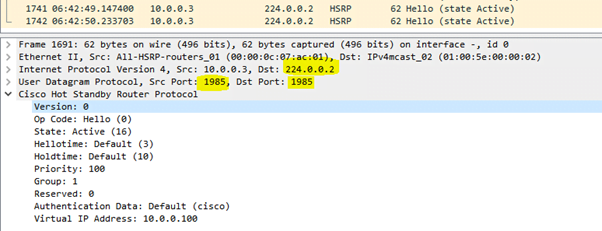
HSRP version 2 use 224.0.0.102 multicast address.
HSRP Vesion-2
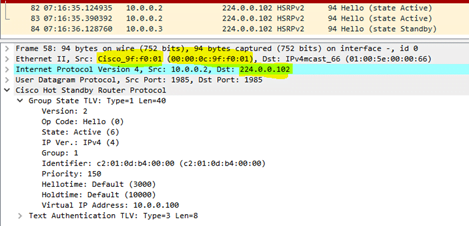
HSRP States
HSRP States is the status of the link as if the status is active link will forward the packet but if a link is in standby mode, it will only listen to the packet not forward.
Initial- This is the first state of HSRP, after configuration or changes of interface this state is in the initial state.
Learn– In this state device is waiting to participate in HSRP from the active router.
Listen– In this state device will listen to the HSRP virtual IP address and hello messages.
Speak– In this state hello message exchanges and participate in the election of active or standby.
Standby– In this state router will be in a standby state and keep hello message sending if the active router either fails or down the link standby will make active.
Active-Only in this state outer will forward the packets to the virtual MAC (Media Access Control) address.
HSRP Terminology
HSRP has many fields like HSRP groups, Hello time, dead timers, virtual IP, Priority, preempt, etc. Here we are mentioning some important fields.
HSRP Group- HSRP Group identifies the HSRP configuration for any specific group. For any HSRP group, both routers should have the same group number. We can configure the 0-255 group in HSRP version 1. Similarly, for HSRP version 2 we can configure the 0-4095 group.
Virtual IP address- In HSRPVirtual IP is the actual gateway for the end host. Hosts have no idea of the physical IP address of the interface (f0/0) for both router active and standby. HSRP virtual IP (10.0.0.100) must be the same on both (Active/Standby) of the routers.
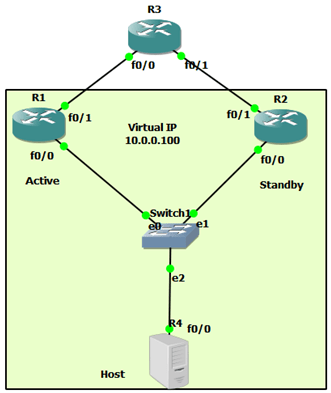
To see the configured virtual IP type the below command
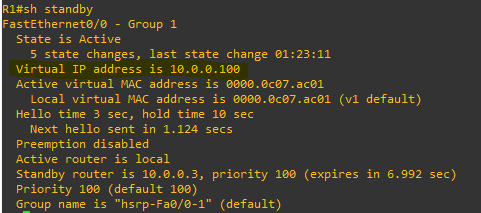
MAC Address: On standby, there is an important role of MAC address. By default, HSRP version-1 generates the virtual MAC0000. 0c07.ac01 last 8 bits is representing the HSRP group number. But for HSRP Version-2 has expended to 12 bits like (001) are represented in decimal 01, and HSRP group 01.
Priority- In HSRP by default Priority is 100, We can change the priority manually to forcefully make the router active or standby. The highest priority will be always elected as Active if preempt is enabled.
Preemption – In HSRP by default preemption is disabled. Use of preempt is to start the election between active and standby routers, after any changes.
We can configure the HSRP in advance to track the ISP (Internet Service Provider) end link goes down with the help of IP SLA.
The Basic Configuration of HSRP
Find the below mentioned basic configuration of HSRP
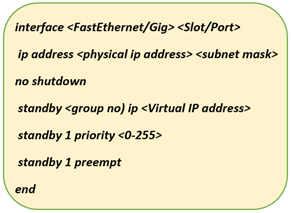
To sum up we can understand that HSRP is a very popular and simple protocol that provides an important role to provides the LAN traffic first-hop redundancy. But the only limitation of this protocol is only used for Cisco devices, we can’t use it in different vendors (like Juniper, Brocade, Arista, etc). Next blog we will cover the advanced HSRP with VRRP and GLBP. For more information and implementation of Network technology kindly visit https://zindagitech.com/ or +91 9773973971.
Author
Brijesh Yadav
Network Consultant Engineer
